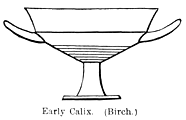Calix
(
κύλιξ).
1.
The drinking-cup, usually made of earthenware, round, with a broad top, feet, and
horizontal handles. The usual capacity
 |
|
Early Calix. (Birch.)
|
was three
cotylae, or 1.3 pints. The
cantharus (q. v.) differed from the
calix in being larger and
having vertical handles. Besides earthenware, other materials are mentioned as used in the
making of
calices— e. g. wood, brass, silver, terebinth
(
τέρμινθος), and possibly glass (Photius, s. h. v.).
Certain places are mentioned by Athenaeus as noted for their manufacture of drinking-cups,
among them Argos, Chios, Lacedaemon, Rhodes, and Teos; and Martial speaks of Surrentum and
Saguntum.
 |
|
Latest Calix. (Birch.)
|
In Juvenal (v. 48) we read of
calices called after a shoemaker of
Beneventum, which had four nozzles. This was Vatinius (
Mart.xiv.
96), who was afterwards a buffoon in the court of Nero (
Ann. xv. 34), and the cups were called
Vatinii (
Mart. x. 3, 4). See
Birch, Ancient Pottery
(1873).
2.
A tube regulating the supply of water, and attached to the end of each pipe where it
entered the castellum of an aqueduct; it was probably of lead in the time of Vitruvius, such
only being mentioned by him; but was made of bronze (
aëneus)
when Frontinus wrote, in order to check the roguery of the
aquarii, who
were able to increase or diminish the flow of water from the reservoir by compressing or
extending the lead. As a further security, the
calix was stamped with
the owner's name as well as the capacity. There are two specimens of such
calices in the Roman museums—one in the Vatican, another in the Museo
Kircheriano. Pipes which had no
calix were termed
solutae.



